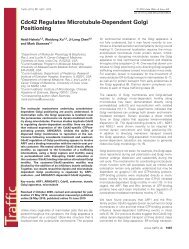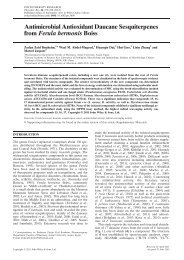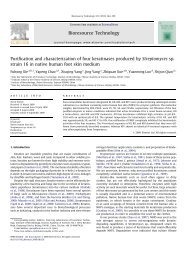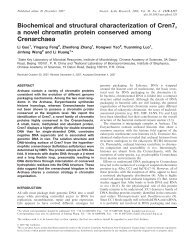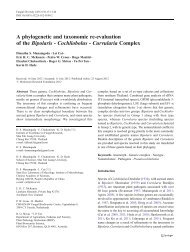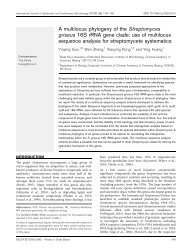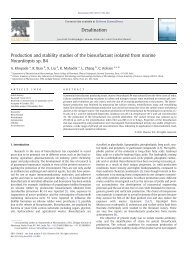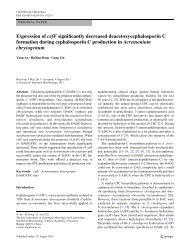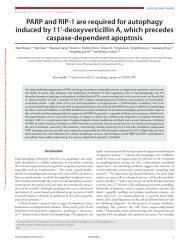Neonectrolide A, a New Oxaphenalenone Spiroketal from the ...
Neonectrolide A, a New Oxaphenalenone Spiroketal from the ...
Neonectrolide A, a New Oxaphenalenone Spiroketal from the ...
You also want an ePaper? Increase the reach of your titles
YUMPU automatically turns print PDFs into web optimized ePapers that Google loves.
<strong>Neonectrolide</strong> A, a <strong>New</strong> <strong>Oxaphenalenone</strong><br />
<strong>Spiroketal</strong> <strong>from</strong> <strong>the</strong> Fungus Neonectria sp.<br />
ORGANIC<br />
LETTERS<br />
XXXX<br />
Vol. XX, No. XX<br />
000–000<br />
Jinwei Ren, †,r Fan Zhang, †,r Xiangyu Liu, ‡ Li Li, § Gang Liu,* ,† Xingzhong Liu, † and<br />
Yongsheng Che* ,^<br />
State Key Laboratory of Mycology, Institute of Microbiology, Chinese Academy<br />
of Sciences, Beijing 100190, People’s Republic of China, College of Resources &<br />
Environment, Huazhong Agricultural University, Wuhan 430070, People’s Republic<br />
of China, Institute of Materia Medica, Chinese Academy of Medical Sciences & Peking<br />
Union Medical College, Beijing 100050, People’s Republic of China, and Beijing Institute<br />
of Pharmacology & Toxicology, Beijing 100850, People’s Republic of China<br />
cheys@im.ac.cn; liug@im.ac.cn<br />
Received October 30, 2012<br />
ABSTRACT<br />
<strong>Neonectrolide</strong> A (1), an oxaphenalenone spiroketal with <strong>the</strong> previously undescribed (5,8 0 -dimethyl-5 0 -oxo-3a 0 ,4,5,5 0 -tetrahydro-3H,3 0 H-spiro[furan-<br />
2,2 0 -isochromeno[3,4,5-def]chromene]-3 0 -yl)but-3-enoic acid skeleton, was isolated <strong>from</strong> cultures of <strong>the</strong> fungus Neonectria sp. Its absolute<br />
configuration was assigned by electronic circular dichroism (ECD) calculations. The skeleton of an oxaphenalenone fused with a 1,6-<br />
dioxaspiro[4.5]decane moiety in 1 could be derived <strong>from</strong> <strong>the</strong> coisolated putative precursors, corymbiferan lactone E (2) and 3-dehydroxy-4-Oacetylcephalosporolide<br />
C (3).<br />
<strong>Oxaphenalenone</strong>s have been isolated frequently <strong>from</strong><br />
fungi and plants. 1 10 The notable structural feature for<br />
this class of natural products is <strong>the</strong> presence of ei<strong>the</strong>r a<br />
† Institute of Microbiology.<br />
‡ Huazhong Agricultural University.<br />
§ Institute of Materia Medica.<br />
^ Beijing Institute of Pharmacology & Toxicology.<br />
r<br />
These authors contributed equally to this work.<br />
(1) Overy, D. P.; Blunt, J. W. J. Nat. Prod. 2004, 67, 1850–1853.<br />
(2) Elsebai, M. F.; Kehraus, S.; Lindequist, U.; Sasse, F.; Shaaban,<br />
S.; C€utschow, M.; Josten, M.; Sahl, H. G.; K€onig, G. M. Org. Biomol.<br />
Chem. 2011, 9, 802–808.<br />
(3) Yamazaki, M.; Okuyama, E. Chem. Pharm. Bull. 1980, 28, 3649–<br />
3655.<br />
(4) Dethoup, T.; Manoch, L.; Kijjoa, A.; Nascimento, M. S. J.;<br />
Puaparoj, P.; Silva, A. M. S.; Eaton, G.; Herz, W. Planta Med. 2006,<br />
72, 957–960.<br />
(5) Dias, D. A.; Goble, D. J.; Silva, C. A.; Urban, S. J. Nat. Prod.<br />
2009, 72, 1075–1080.<br />
(6) Opitz, S.; H€olscher, D.; Oldham, N. J.; Bartram, S.; Schneider, B.<br />
J. Nat. Prod. 2002, 65, 1122–1130.<br />
(7) Hirai, N.; Ishida, H.; Koshimizu, K. Phytochemistry 1994, 37,<br />
383–385.<br />
benzo[de]isochromen-1(3H)-one or a benzo[de]chromen-<br />
2(3H)-one skeleton, in which <strong>the</strong> naphthalene unit fused<br />
with <strong>the</strong> δ-lactone moiety in A or B mode of junction<br />
(Figure 1), respectively. <strong>Oxaphenalenone</strong>s are an important<br />
class of compounds showing various biological effects.<br />
Examples include bacillosporins A C, <strong>the</strong> dimeric<br />
oxaphenalenones isolated <strong>from</strong> <strong>the</strong> fungus Talaromyces<br />
bacillisporus as mycotoxins and antibacterial agents; 3 conioscleroderolide,<br />
an antibacterial and cytotoxic metabolite<br />
<strong>from</strong> a marine-derived fungus Coniothyrium cereale; 2<br />
2-(4 0 -hydroxyphenyl)-naphthalic anhydride, a phytoalexin<br />
<strong>from</strong> <strong>the</strong> unripe green fruit banana Musa acuminata; 7 and<br />
scleroderolide, a cholesteryl ester transfer protein (CEPT)<br />
inhibitor <strong>from</strong> a Penicillium sp. FO-5637. 10<br />
(8) Steffan, B.; Steglich, W. Angew. Chem., Int. Ed. 1984, 23, 445–447.<br />
(9) Ayer, W. A.; Hoyano, Y.; Pedras, M. S.; Clardy, J.; Arnold, E.<br />
Can. J. Chem. 1987, 65, 748–753.<br />
(10) Tomoda, H.; Tabata, N.; Masuma, R.; Si, S.; Omura, S.<br />
J. Antibiot. 1998, 51, 618–623.<br />
10.1021/ol302979f<br />
r XXXX American Chemical Society
In a search for new cytotoxic metabolites <strong>from</strong> rarely<br />
studied fungi inhabiting unique environments, a strain of<br />
Neonectria sp. isolated <strong>from</strong> a soil sample that was collected<br />
<strong>from</strong> <strong>the</strong> Qinghai-Tibetan plateau (N: 28°27 0 ,E:<br />
97°02 0 ), Chayu, Tibet, People’s Republic of China, was<br />
chemically investigated. Although <strong>the</strong> Neonectria is a common<br />
fungal genus, its chemistry remained largely unexplored.<br />
11 Fractionation of an EtOAc extract prepared<br />
<strong>from</strong> a solid-substrate fermentation culture afforded<br />
neonectrolide A (1), an oxaphenalenone spiroketal with<br />
<strong>the</strong> new skeleton of 4,5-dihydro-3H,3 0 H-spiro[furan-2,2 0 -<br />
isochromeno[3,4,5-def]chromen]-5 0 (3a 0 H)-one. Two new<br />
metabolites, corymbiferan lactone E (2) and 3-dehydroxy-<br />
4-O-acetylcephalosporolide C (3), were also isolated as <strong>the</strong><br />
putative biosyn<strong>the</strong>tic precursors of 1. Details of <strong>the</strong> structure<br />
elucidation and cytotoxicity of 1 3, aswellasplausible<br />
biogenesis of 1 are reported herein.<br />
Figure 1. Two modes of junction in oxaphenalenones.<br />
C-4, and of C-1 and C-3 to <strong>the</strong> same oxygen atom,<br />
establishing a δ-lactone unit (ring C) fused with <strong>the</strong><br />
naphthalene at C-11/C-11a/C-4. In turn, HMBC correlations<br />
<strong>from</strong> H-4 0 ,H-5 0 ,H 2 -7 0 ,andH 2 -8 0 to C-6 0 located C-6 0<br />
between C-5 0 and C-7 0 . Considering <strong>the</strong> doubly oxygenated<br />
nature of C-6 0 , and <strong>the</strong> chemical shifts for C-5 (δ C 150.6)<br />
and C-9 0 (δ C 76.9), <strong>the</strong> two C-6 0 bonded oxygen atoms were<br />
individually attached to C-5 and C-9 0 to form a 1,6-<br />
dioxaspiro[4.5]decane moiety to satisfy <strong>the</strong> unsaturation<br />
requirement of 1, even though no additional evidence for<br />
<strong>the</strong>se linkages were provided by <strong>the</strong> HMBC data. Collectively,<br />
<strong>the</strong>se data (Figure 2) permitted assignment of <strong>the</strong><br />
planar structure of 1.<br />
<strong>Neonectrolide</strong> A (1) was assigned a molecular formula<br />
of C 25 H 26 O 8 (13 degrees of unsaturation) by HRESIMS<br />
(m/z 477.1525 [M þ Na] þ ; Δ 0.5 mmu). Analysis of its<br />
NMR data (Table 1) revealed one exchangeable proton<br />
(δ H 11.64), four methyl groups (two methoxys), three<br />
methylenes, three methines (two oxymethines), 12 aromatic/<br />
olefinic carbons with four protonated, one doubly oxygenated<br />
sp 3 quaternary carbon (δ C 111.3), and two carboxylic<br />
carbons (δ C 170.9 and 171.9, respectively). The<br />
1 H 1 H COSY NMR data of 1 defined <strong>the</strong> two isolated<br />
spin systems of C-7 0 C-10 0 and C-2 0 C-3 (via C-5 0 ), and<br />
<strong>the</strong> latter was attached to <strong>the</strong> C-1 0 methyl formate on <strong>the</strong><br />
basis of HMBC correlations <strong>from</strong> H 2 -2 0 and H 3 -11 0 to C-1 0 .<br />
HMBC cross peaks <strong>from</strong> H-9 to C-7a, C-10, C-11, and<br />
C-12, H-6 to C-4, C-5, C-7, and C-7a, H 3 -12 to C-7a, C-8,<br />
and C-9, and <strong>from</strong> <strong>the</strong> intramolecularly hydrogen-bonded<br />
phenolic proton at 11.64 ppm to C-9, C-10, and C-11, plus<br />
chemical shift (δ C 132.7) consideration of <strong>the</strong> remaining<br />
aromatic carbon (C-11a) in 1, a naphthalene unit (rings A<br />
and B) was established with a methyl and a hydroxy group<br />
located at C-8 and C-10, respectively. A weak, but distinct<br />
four-bond W-type correlation <strong>from</strong> H-9 to C-1 connected<br />
<strong>the</strong> C-1 carboxylic carbon (δ C 170.9) to C-11, 12 whereas<br />
that of H 3 -13 with C-7 indicated that <strong>the</strong> C-13 methoxy<br />
unit is attached to C-7. Fur<strong>the</strong>r correlations <strong>from</strong> H-3 to<br />
C-1, C-4, C-5, and C-11a enabled <strong>the</strong> connections of C-3 to<br />
(11) Shiono, Y.; Shimanuki, K.; Hiramatsu, F.; Koseki, T.; Tesuya,<br />
M.; Fujisawa, N.; Kimura, K. Bioorg. Med. Chem. Lett. 2008, 18, 6050–<br />
6053.<br />
(12) (a) Zhang, F.; Li, L.; Niu, S.; Si, Y.; Guo, L.; Jiang, X.; Che, Y.<br />
J. Nat. Prod. 2012, 75, 230–237. (b) Li, E.; Zhang, F.; Niu, S.; Liu, S.;<br />
Liu, X.; Liu, G.; Che, Y. Org. Lett. 2012, 14, 3320–3323.<br />
B<br />
Table 1. NMR Spectroscopic Data for 1 in CDCl 3<br />
pos. δ H a (J in Hz) δ C<br />
b<br />
HMBC (H f C#)<br />
1 170.9<br />
3 5.99, d (6.0) 72.9 1, 4, 5, 11a, 4 0 ,5 0<br />
4 98.1<br />
5 150.6<br />
6 6.31, s 95.7 3, 4, 5, 7, 7a<br />
7 160.0<br />
7a 113.6<br />
8 147.7<br />
9 6.76, s 118.2 1, 7a, 10, 11, 12<br />
10 163.2<br />
11 98.2<br />
11a 132.7<br />
12 2.80, s 25.4 7a, 8, 9<br />
13 3.94, s 55.5 7<br />
1 0 171.9<br />
2 0 3.09, m c ; 37.8 1 0 ,3 0 ,4 0<br />
3.01, dd (17.0, 8.0)<br />
3 0 5.97, m c 128.9 1 0 ,2 0 ,5 0<br />
4 0 5.44, dd (15.5, 10.0) 127.2 3, 2 0 ,5 0 ,6 0<br />
5 0 3.08, dd (10.0, 6.0) 47.5 3, 4, 3 0 ,6 0<br />
6 0 111.3<br />
7 0 2.25, m 36.2 5 0 ,6 0 ,8 0 ,9 0<br />
8 0 2.30, m; 1.62, m 30.9 6 0 ,7 0 ,9 0 ,10 0<br />
9 0 4.46, m 76.9<br />
10 0 1.25, d (6.0) 21.0 8 0 ,9 0<br />
11 0 3.68, s 51.9 1 0<br />
OH-10 11.64, s 9, 10, 11<br />
a Recorded at 500 MHz. b Recorded at 125 MHz. c Mutiplicity due to<br />
signal overlapping.<br />
The C-3 0 /C-4 0 olefin was assigned E-geometry on <strong>the</strong><br />
basis of <strong>the</strong> large (15.5 Hz) coupling constant observed<br />
Org. Lett., Vol. XX, No. XX, XXXX
etween H-3 0 and H-4 0 . 13 NOESY correlations of H 2 -7 0<br />
with H-3 0 and H-4 0 were used to place <strong>the</strong>se protons on <strong>the</strong><br />
same face of ring D, whereas those of H-9 0 with H-5 0<br />
revealed <strong>the</strong>ir spatial proximity (Figure 2). The absolute<br />
configuration of 1 was deduced by comparison of <strong>the</strong><br />
experimental and simulated electronic circular dichroism<br />
(ECD) spectra generated by time-dependent density<br />
functional <strong>the</strong>ory (TDDFT). 14 Considering <strong>the</strong> abovementioned<br />
NOESY data, one of <strong>the</strong> four stereoisomers,<br />
(3S,5 0 R,6 0 R,9 0 R)-1, (3R,5 0 S,6 0 S,9 0 S)-1, (3S,5 0 S,6 0 S,9 0 S)-1,<br />
and (3R,5 0 R,6 0 R,9 0 R)-1, should represent <strong>the</strong> actual configuration<br />
of 1. Since <strong>the</strong> 6/6/6/5 ring system in 1<br />
was relatively rigid, which would significantly affect <strong>the</strong><br />
CD property, whereas <strong>the</strong> conformationally flexible side<br />
chain had insignificant effect on <strong>the</strong> CD spectrum of 1, a<br />
Figure 2. Selected key HMBC and NOESY correlations of 1.<br />
simplified structure 4 was used for ECD calculations<br />
(Figure 3). A systematic conformational analysis was<br />
performed for 4a 4d by <strong>the</strong> Molecular Operating Environment<br />
(MOE) software package using <strong>the</strong> MMFF94 molecular<br />
mechanics force field calculation. The MMFF94<br />
conformational search followed by reoptimization using<br />
TDDFT at B3LYP/6-31G(d) basis set level afforded three<br />
lowest-energy conformers for enantiomers 4a and 4b and<br />
two for 4c and 4d, respectively (Figures S7 and S8, Supporting<br />
Information). The overall calculated ECD spectra<br />
of 4a 4d were <strong>the</strong>n generated by Boltzmann-weighting of<br />
<strong>the</strong> conformers. The absolute configuration of 1 was<br />
extrapolated by comparison of <strong>the</strong> experimental and calculated<br />
ECD spectra of 4a 4d (Figure 3). The experimentalCDspectrumof1<br />
was nearly identical to <strong>the</strong> calculated<br />
ECD spectrum of (3R,5 0 S,6 0 S,9 0 S)-4 (4b), both showing<br />
positive Cotton effects (CEs) in 230 265 nm, and negative<br />
CEs in <strong>the</strong> regions of 270 295 and 295 400 nm (Figure 3).<br />
The energy-minimized conformer of 4b showed a dihedral<br />
(13) Ding, G.; Li, Y.; Fu, S.; Liu, S.; Wei, J.; Che, Y. J. Nat. Prod.<br />
2009, 72, 182–186.<br />
(14) (a) Diedrich, C.; Grimme, S. J. Phys. Chem. A 2003, 107, 2524–<br />
2539. (b) Crawford, T. D.; Tam, M. C.; Abrams, M. L. J. Phys. Chem. A<br />
2007, 111, 12058–12068. (c) Stephens, P. J.; Devlin, F. J.; Gasparrini, F.;<br />
Ciogli, A.; Spinelli, D.; Cosimelli, B. J. Org. Chem. 2007, 72, 4707–4715.<br />
(d) Ding, Y.; Li, X. C.; Ferreira, D. J. Org. Chem. 2007, 72, 9010–9017.<br />
(e) Berova, N.; Bari, L. D.; Pescitelli, G. Chem. Soc. Rev. 2007, 36, 914–<br />
931. (f) Bringmann, G.; Bruhn, T.; Maksimenka, K.; Hemberger, Y.<br />
Eur. J. Org. Chem. 2009, 17, 2717–2727.<br />
Org. Lett., Vol. XX, No. XX, XXXX<br />
angle of 47.0° between H-3 and H-5 0 (Figure S21, Supporting<br />
Information), corresponding to a 3 J HH value of 6.0 Hz<br />
<strong>from</strong> <strong>the</strong> Karplus equation ( 3 J HH = A þ B cosΦ þ C<br />
cos2Φ; A =7,B = 1, C =5,Φ = dihedral angle). 15,16<br />
Whereas <strong>the</strong> dihedral angle between H-3 and H-5 0 was<br />
calculated as 174.4° in conformer 4d (Figure S22, Supporting<br />
Information), with a <strong>the</strong>oretical 3 J HH value of 13 Hz,<br />
<strong>the</strong> actual 3 J HH value observed between H-3 and H-5 0 in 1<br />
was 6.0 Hz, matching that calculated in 4b, supporting <strong>the</strong><br />
absolute configuration deduced <strong>from</strong> <strong>the</strong> ECD spectra.<br />
Therefore, 1 was deduced to have <strong>the</strong> 3R,5 0 S,6 0 S,and9 0 S<br />
absolute configuration.<br />
Compound 2 gave a pseudomolecular ion [M þ H] þ<br />
peak at m/z 261.0755 by HRESIMS, consistent with <strong>the</strong><br />
molecular formula C 14 H 12 O 5 .Its 1 Hand 13 C NMR spectra<br />
showed resonances for two exchangeable protons (δ H<br />
10.12 and 11.99, respectively), two methyl groups (one<br />
methoxy), one oxymethylene, 10 sp 2 carbons with two<br />
protoned, and one carboxylic carbon (δ C 170.3). Analysis<br />
of its NMR data revealed structural similarity to corymbiferan<br />
lactone A, 1 except that <strong>the</strong> C-7 methoxy, C-5 hydroxy,<br />
and C-4 hydroxymethyl group in corymbiferan lactone<br />
A were replaced by a hydroxy, a methoxy, and a methyl<br />
group in 2, respectively, which were supported by relavant<br />
HMBC data, completing <strong>the</strong> planar structure of 2 as<br />
shown. (Note: A different numbering system was used<br />
for 2, in which C-7, C-5, and C-4 in corymbiferan lactone A<br />
corresponded to C-5, C-7, and C-8 in 2, respectively.)<br />
Compound 3 was assigned <strong>the</strong> molecular formula<br />
C 12 H 18 O 5 by HRESIMS (m/z 265.1056 [M þ Na] þ ; Δ<br />
0.4 mmu). Its 1 Hand 13 C NMR data were consistent with<br />
those for two methyls, five methylenes, two oxymethines,<br />
two carboxylic carbons (δ C 172.1 and 170.0), and a ketone<br />
carbon (δ C 208.4). The NMR data of 3 were nearly<br />
identical to those of cephalosporolide C, 17 both having<br />
<strong>the</strong> 10-methyloxecane-2,7-dione moiety. Interpretation of<br />
<strong>the</strong> 2D NMR data of 3 established its structure as 3-dehydroxy-<br />
4-O-acetylcephalosporolide C. The relative configuration<br />
of 3 was deduced by NOED data. Upon irradiation<br />
of H-4, enhancement was observed for H-7b in <strong>the</strong> NOE<br />
difference spectrum of 3, whereas enhancement was<br />
observed for H-7a upon irradiation of H-9, suggesting a<br />
trans relationship between H-4 and H-9.<br />
The absolute configuration of 3 was assigned using <strong>the</strong><br />
modified Mosher’s method on <strong>the</strong> semisyn<strong>the</strong>tic product 5<br />
(Figure S25, Supporting Information). 18 Specifically,<br />
treatment of 3 with NaOH MeOH afforded 5, andsubsequent<br />
treatment of 5 with (S)- and (R)-MTPA Cl<br />
afforded <strong>the</strong> R-(5a)andS-MTPA (5b) esters, respectively.<br />
The difference in chemical shift values (Δδ = δ S δ R )for<br />
<strong>the</strong> diastereomeric esters 5b and 5a was calculated to assign<br />
<strong>the</strong> 4R absolute configuration (Figure S25, Supporting<br />
(15) Pavia, D. L.; Lampman, G. M.; Kriz, G. S. Introduction of<br />
Spectroscopy; Thomson Learning, Ltd.: London, 2001.<br />
(16) Crews, P.; Rodriguez, J.; Jaspars, M. Organic Structure Analysis;<br />
Oxford University Press: <strong>New</strong> York, 1998.<br />
(17) Rukachaisirikul, Y.; Pramjie, S.; Pakawatchai, C.; Isaka, M.;<br />
Supothina, S. J. Nat. Prod. 2004, 67, 1953–1955.<br />
(18) Ohtani, I.; Kusumi, T.; Kashman, Y.; Kakisawa, H. J. Am.<br />
Chem. Soc. 1991, 113, 4092–4096.<br />
C
een previously reported, which incorporated ei<strong>the</strong>r<br />
a 3 0 ,3a 0 ,4,5,5 0 ,6 0 ,6a 0 ,7 0 -octahydro-3H-spiro[furan-2,2 0 -<br />
pyrano [2,3,4-de]chromene] 19 21 or a 1,2,4 0 ,5 0 -tetrahydro-<br />
3 0 H-spiro[benzo[f]chromene-3,2 0 -furan] core, 22 compound<br />
1 possesses <strong>the</strong> previously undescribed (5,8 0 -dimethyl-5 0 -<br />
oxo-3a 0 ,4,5,5 0 -tetrahydro-3H,3 0 H-spiro[furan-2,2 0 -isochromeno[3,4,5-def]chromene]-3<br />
0 -yl)but-3-enoic acid skeleton<br />
originated <strong>from</strong> fusion of an oxaphenalenone and an 1,6-<br />
dioxaspiro[4.5]decane unit. Biosy<strong>the</strong>tically, compound 3,<br />
<strong>the</strong> 10-membered lactone with <strong>the</strong> C-9 methyl group, could<br />
be derived <strong>from</strong> a 10-carbon phenol via a serious of<br />
oxadative reactions. 23 In addition, compound 1 could be<br />
generated <strong>from</strong> <strong>the</strong> coisolated 2 and 3 via <strong>the</strong> reaction<br />
cascades as illustrated in <strong>the</strong> hypo<strong>the</strong>tical biosyn<strong>the</strong>tic pathways<br />
(Scheme 1).<br />
Scheme 1. Hypo<strong>the</strong>tical Biosyn<strong>the</strong>tic Pathways for 1<br />
Figure 3. The experimental CD spectrum of 1 in MeOH and <strong>the</strong><br />
calculated ECD spectra of 4a 4d. Structures 4a 4d represent<br />
four possible stereoisomers of 4.<br />
Information). Therefore, <strong>the</strong> 4R and 9S absolute configuration<br />
was proposed for 3.<br />
Compounds 1 3 were tested for cytotoxicity against<br />
human tumor cell lines, HeLa, A549, HCT116, and<br />
T24. Compounds 1 and 3 were cytotoxic to T24 cells,<br />
showing IC 50 values of 47.1 and 19.0 μM, respectively (<strong>the</strong><br />
positive control cisplatin showed an IC 50 value of 22.1 μM),<br />
whereas 2 did not show detectable activity at 50 μg/mL.<br />
Compound 1 is a new member of <strong>the</strong> oxaphenalenonederived<br />
natural products. Although several syn<strong>the</strong>tic compounds<br />
with partial structural similarity to 1 have<br />
(19) Zhou, J.; Snider, B. B. Org. Lett. 2007, 9, 2071–2074.<br />
(20) Snaddon, T. N.; Buchgraber, P.; Schulthoff, S.; Wirtz, C.;<br />
Mynott, R.; Furstner, A. Chem.;Eur. J. 2010, 16, 12133–12140.<br />
(21) Fananas, F.; Mendoza, A.; Arto, T.; Temelli, B.; Rodriguez, F.<br />
Angew. Chem., Int. Ed. 2012, 51, 4930–4933.<br />
(22) Barluenga, J.; Mendoza, A.; Rodrigue, F.; Fananas J. Angew.<br />
Chem. Int. Ed. 2009, 48, 1644–1647.<br />
Acknowledgment. We thank Mr. Zhufeng Geng of<br />
Analytical and Testing Center, Beijing Normal University<br />
for conducting NMR experiments. Financial support<br />
<strong>from</strong> <strong>the</strong> National Natural Science Foundation of China<br />
(30925039 and 81001380), <strong>the</strong> Beijing Natural Science Foundation<br />
(5111003), and <strong>the</strong> Ministry of Science and Technology<br />
of China (2012ZX09301-003 and 2009CB522300) is<br />
gratefully acknowledged.<br />
Supporting Information Available. Experimental procedures,<br />
characterization data, 1 H and 13 C APT NMR<br />
spectra of 1 3, and UV and CD calculations for 1. This<br />
material is available free of charge via <strong>the</strong> Internet at<br />
http://pubs.acs.org.<br />
(23) Barradas, S.; Urbano, A.; Carreno, M. C. Chem.;Eur. J. 2009,<br />
15, 9286–9289.<br />
The authors declare no competing financial interest.<br />
D<br />
Org. Lett., Vol. XX, No. XX, XXXX




